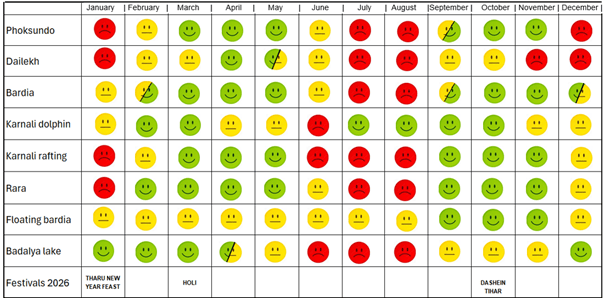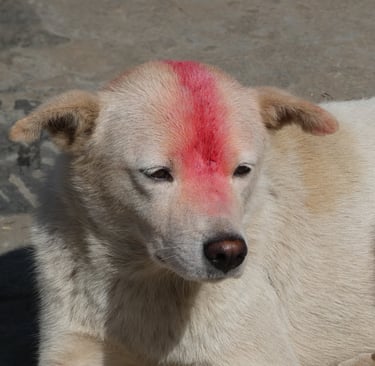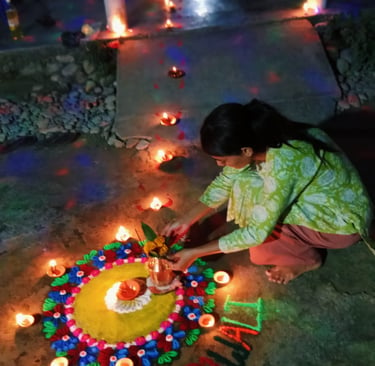When to Travel ?
Travel in Harmony with the Seasons and Local Festivals
Nepal can be visited year-round, but the high tourist season runs from October to April, when the weather is generally pleasant with plenty of sunshine.
The monsoon season lasts from mid-June to mid-September, corresponding to the low tourist season. Rainfall is heaviest during these months, especially in the southern plains, while some inner valleys and northern slopes remain relatively dry.
Nepal’s climate varies with altitude:
Southern plains: subtropical, with a pronounced rainy season
Lower mountains: temperate
Himalayan peaks: frigid and often snow-covered
In general, eastern southern slopes receive more rain than western slopes at the same altitude.


Best Periods : Seasonal Highlights
Tihar
Festival of Lights
Experience Tihar, Nepal’s vibrant festival of lights and colors! Celebrated over five days, this festival honors Yama, the god of death, while worshiping Laxmi, the goddess of wealth. Homes are beautifully illuminated with candles, oil lamps, and electric lights, creating a magical atmosphere.
During Tihar, brothers give gifts to their sisters, and the festivities often end with a feast. It is also customary to go from house to house singing Tihar songs and offering blessings, after which households traditionally give money in return. Fireworks light up the sky, despite government restrictions on firecrackers, adding to the festival’s joyful spirit.
Dashain
Plan your visit to Nepal during Dashain to experience the country’s rich cultural and natural heritage.
Dashain is the longest Hindu festival in Nepal, celebrated over two weeks with prayers and offerings to Durga, the Universal Mother Goddess. As the major harvest festival, it is a time for family gatherings, gift exchanges, blessings, and elaborate pujas. The festival honors Goddess Durga, who embodies the shakti (energy) of all the gods and wields their divine weapons.
Visit Nepal to Enjoy Its Vibrant Festivals


Nepal is a culturally rich country, celebrating numerous festivals with joy and vibrancy. As a multiethnic nation, each festival is observed in its own unique and lively way, reflecting the traditions and beliefs of different communities. Nepal truly is a land of festivals, offering a wide variety of celebrations, each with its own distinct character.
Teej
Teej is celebrated annually between August and early September, according to the Hindu calendar, spanning three days of tradition, devotion, and emotion.
Day 1 – Celebration: Women dress in bright red saris, adorn themselves with tikās and sparkling bracelets, and gather to sing and dance to traditional folk tunes, filling the streets with color and joy.
Day 2 – Fasting: Women observe a strict fast—no food or water—while continuing to dance and sing, often for hours under the monsoon sun. This ritual honors Goddess Parvati, commemorating her sacred union with Lord Shiva.
Day 3 – Prayers: Devotees visit Shiva temples, offering prayers for the health and longevity of their husbands and children. Long lines of faithful form outside sanctuaries, creating a moving spiritual scene.
The name “Teej” comes from a tiny red insect appearing during the monsoon, symbolizing life and renewal. Through its dances, songs, and ascetic rituals, Teej celebrates the resilience and courage of Nepali women, remaining one of the country’s most vibrant and heartfelt festivals.


ADVENTURE SAFARI & TREK
Experience Nepal’s hidden gems: from majestic landscapes to living traditions.
